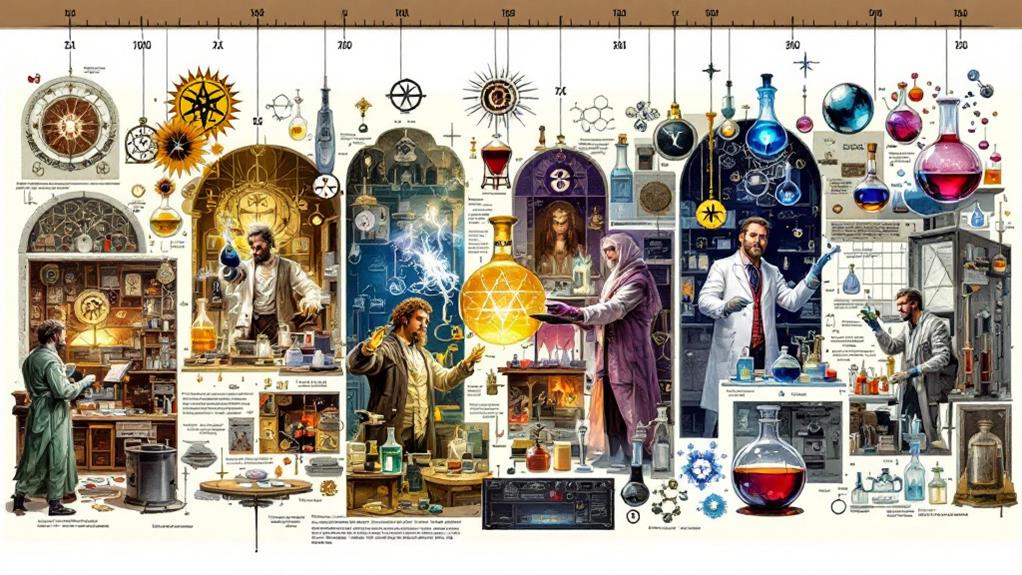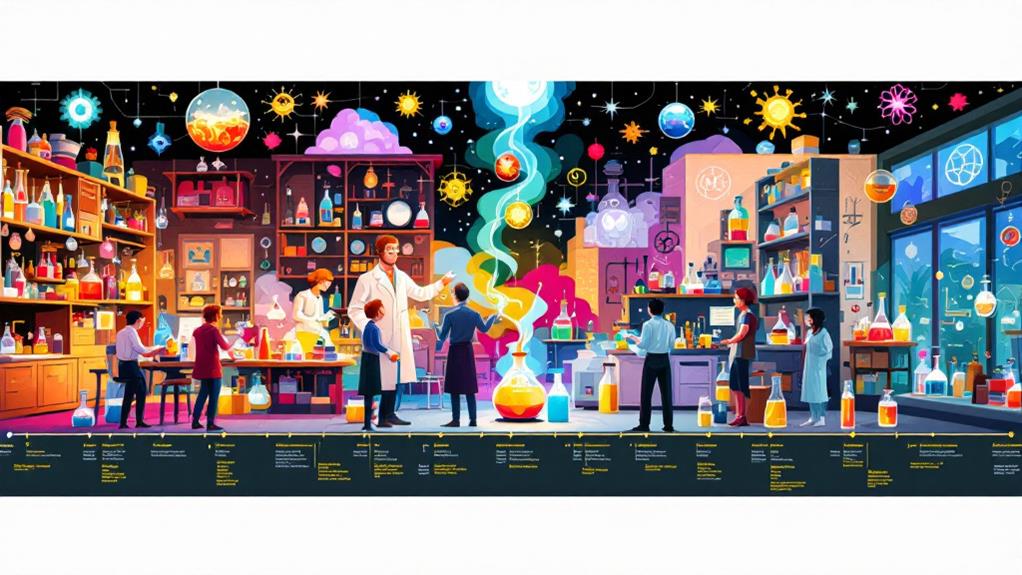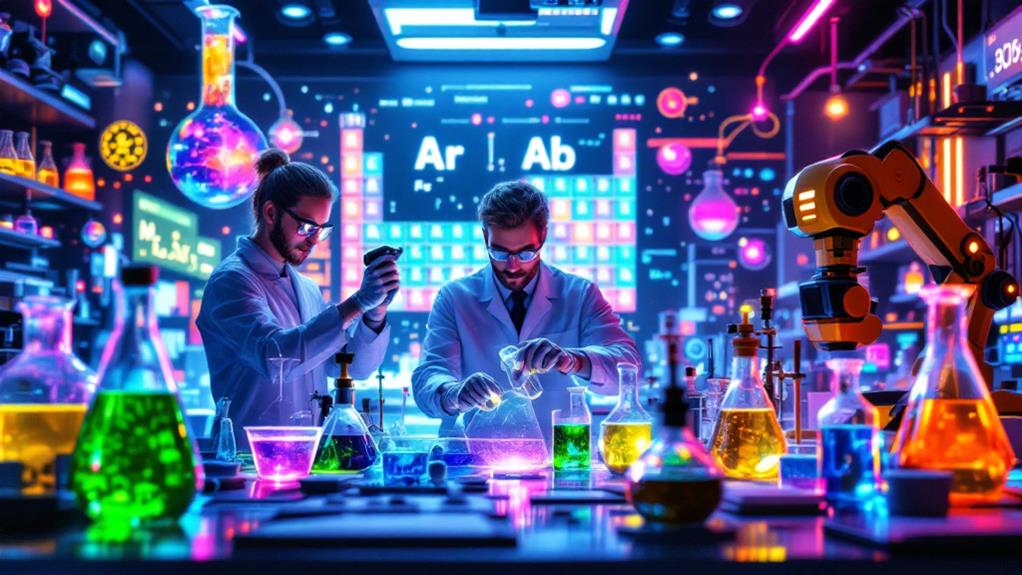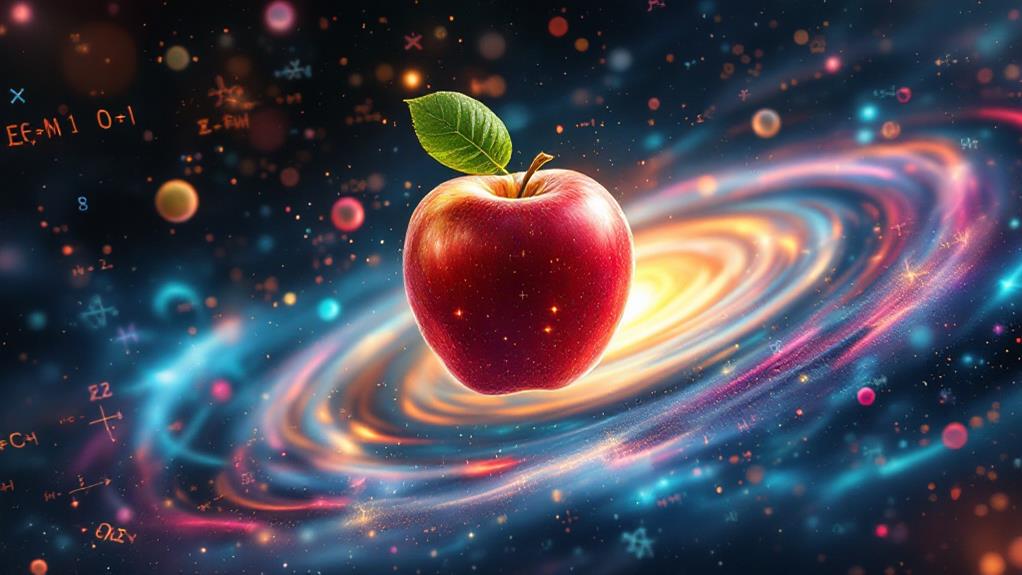The History of Chemistry: From Alchemy to Modern Science

You start exploring the expedition of chemistry from ancient alchemy, where mystical symbols and the pursuit of gold defined the art. Alchemists laid the philosophical groundwork for modern science, even using lab equipment like alembics. With the scientific revolution, figures like Robert Boyle shifted focus to experimentation and atomic theory, moving away from mystical elements. The Enlightenment ushered in the scientific method, promoting reason and collaboration. As industrialization took hold, chemistry evolved further, impacting production and raising environmental questions. Today's green chemistry and innovations in pharmaceuticals highlight its continuous role in shaping a sustainable future. More awaits by traveling further into this rich history.
Origins of Alchemy
Alchemy, often seen as the mystical precursor to modern chemistry, has its origins rooted in ancient civilizations. When you examine alchemy's beginnings, you'll find it deeply intertwined with philosophical foundations and mystical symbolism. Ancient Egyptians, Greeks, and Chinese all contributed to alchemy's early development, each culture adding its own unique layer of thought and symbolism. You might recognize that alchemy wasn't just about turning base metals into gold; it was a philosophical expedition, aiming to understand the universe and humanity's place within it.
In your expedition through alchemy's origins, you'll notice how the philosophical foundations were vital. Alchemists believed that everything in the universe was interconnected. For them, transforming metals reflected a deeper transformation of the self, a process rich with mystical symbolism. Symbols like the ouroboros, a serpent eating its own tail, represented the eternal cycle of creation and destruction, a significant concept in alchemical thought.
As you investigate further, you'll see alchemy as a blend of science, art, and spirituality. It set the stage for modern chemistry by encouraging observation and experimentation, even as it wrapped scientific ideas in layers of mystical symbolism and philosophical inquiry.
Medieval Alchemical Practices
During the medieval period, alchemical practices evolved considerably, blending mystical traditions with emerging scientific methods. You'd find alchemists passionately pursuing the elusive philosopher's stone, a substance they believed could achieve the transmutation of base metals into gold. These transmutation theories weren't just about material wealth; they embodied the deeper quest for spiritual transformation.
As you investigate the world of medieval alchemy, you'll encounter a rich tapestry of mystical symbols and alchemical texts. These served as guides and coded messages, often decipherable only by those initiated into secret societies. Such societies safeguarded their knowledge, wary of persecution and keen to preserve their sacred traditions.
In the alchemist's laboratory, you'd see primitive yet fascinating laboratory equipment. Apparatus like alembics and crucibles filled these secretive spaces, used to examine the elemental correspondences that alchemists believed connected the physical and spiritual worlds.
The pursuit of alchemy was much more than mere experimentation; it was an expedition into the mystical and the unknown. By engaging with these practices, alchemists sought not just to alter metals but to reveal the hidden mysteries of existence itself.
The Birth of Modern Chemistry
While alchemists tirelessly sought mystical transformation, the seeds for modern chemistry were quietly being sown. You'd find that during the scientific revolution, a new way of thinking began to challenge the old alchemical traditions. This period wasn't just about uncovering new ideas; it was also about questioning established beliefs. The elemental theory, for instance, underwent significant scrutiny. Instead of relying on the ancient idea of four elements—earth, water, air, and fire—scientists started to investigate matter based on observation and experimentation.
You'd see that Robert Boyle played an essential role in this transformation. He didn't just question the elemental theory; he also introduced the concept that matter is composed of tiny particles, laying groundwork for atomic theory. Boyle's insistence on experimentation over speculation marked a clear departure from alchemy. His work, "The Sceptical Chymist," challenged the traditional views and emphasized the importance of a scientific approach.
Enlightenment and Scientific Method
The Enlightenment's influence on chemistry cannot be overstated; it was a period where reason and empirical evidence took center stage. During this time, you see a shift from mystical explanations to rational inquiry. Instead of relying on ancient texts or alchemical rituals, you begin to value empirical observation. This means you test hypotheses and gather data to form findings, a practice that forms the bedrock of the scientific method.
Imagine you're a scientist in the 18th century. You're no longer satisfied with vague explanations. Instead, you ask questions and conduct experiments to understand the natural world. You record your observations carefully, and you're driven by a curiosity to reveal the truth. This approach revolutionizes chemistry, moving it away from alchemy's mystical roots.
You find that collaboration becomes key. Scientists share their findings, debate ideas, and refine theories based on evidence. This collective effort accelerates progress, and chemistry begins to emerge as a distinct scientific discipline. During the Enlightenment, you realize that knowledge is no longer the property of a few but a shared pursuit. This democratization of science empowers you to make revelations grounded in reality.
Key Discoveries in Chemistry

As the Enlightenment reshapes the scientific landscape with its emphasis on reason and empirical evidence, chemistry witnesses groundbreaking revelations that redefine understanding. You reveal the secrets of chemical bonding, realizing how atoms connect to form molecules. This revelation offers insight into molecular structures and transforms the study of organic compounds. With the introduction of spectroscopy techniques, you can now examine how light interacts with matter, revealing valuable information about elements and compounds.
The periodic table emerges as a powerful tool, organizing elements by their properties and guiding you in predicting their behavior. This systematic approach improves your understanding of element identification, allowing you to identify new elements and enrich the known chemical world. In addition, you investigate reaction rates, uncovering how factors like temperature and concentration impact the speed of chemical reactions. This knowledge helps you control and optimize reactions for different applications.
Thermodynamic principles offer a deeper understanding of energy changes in chemical processes, providing a framework to predict the spontaneity of reactions. By mastering these principles, you gain insight into the energy dynamics of chemical transformations, paving the way for further advancements in the field.
Chemistry in the Industrial Age
During the Industrial Revolution, the chemical industry undergoes transformative changes that revolutionize production processes and materials. You see the birth of large-scale chemical manufacturing, where industrial processes become more efficient and widespread. This period witnesses the creation of synthetic materials that change daily life, from clothing to construction. With the growth of industries, there's an inevitable environmental impact, sparking the initial discussions on pollution and waste management.
Consider these vivid images:
- Vast factories with towering chimneys billowing smoke: showcasing the power and scale of the new industrial period.
- Rows of colorful synthetic dyes: representing the explosion of possibilities in textiles and design.
- Laboratories teeming with scientists: pushing the boundaries in pharmaceutical advancements.
- Streams and rivers tainted with chemical runoff: a stark reminder of the environmental consequences.
In this timeframe, chemistry doesn't just serve scientific curiosity; it becomes integral to industrial applications. The breakthroughs in pharmaceuticals improve health and longevity, while innovations in synthetic materials offer durability and versatility previously unimaginable. However, these advancements come with the responsibility to address their environmental impact, a challenge that continues to shape the chemical industry today.
Contemporary Chemical Innovations

In the current rapidly evolving world, chemistry stands at the forefront of innovation, driving solutions to some of the most pressing global challenges. You're witnessing a period where sustainable materials are transforming industries, reducing environmental impact, and promoting eco-friendly practices. Green chemistry principles guide the development of these materials, ensuring that processes minimize waste and energy consumption. As you investigate this field, you'll see how interdisciplinary collaborations are essential, as chemists partner with engineers, biologists, and environmental scientists to create groundbreaking solutions.
In pharmaceuticals, advancements are accelerating, offering you new treatments and therapies for previously incurable diseases. With nanotechnology applications, drugs are becoming more precise, targeting only diseased cells and minimizing side effects. This precision medicine is changing healthcare, offering you better outcomes and improved quality of life.
Chemical education is also adapting to these changes, emphasizing the importance of sustainability and innovation. You'll find that modern chemistry curricula now focus on real-world applications and problem-solving skills, preparing you to contribute to future breakthroughs. Welcome these contemporary innovations, as they hold the key to a sustainable, healthier world and highlight the endless possibilities within the domain of chemistry.



